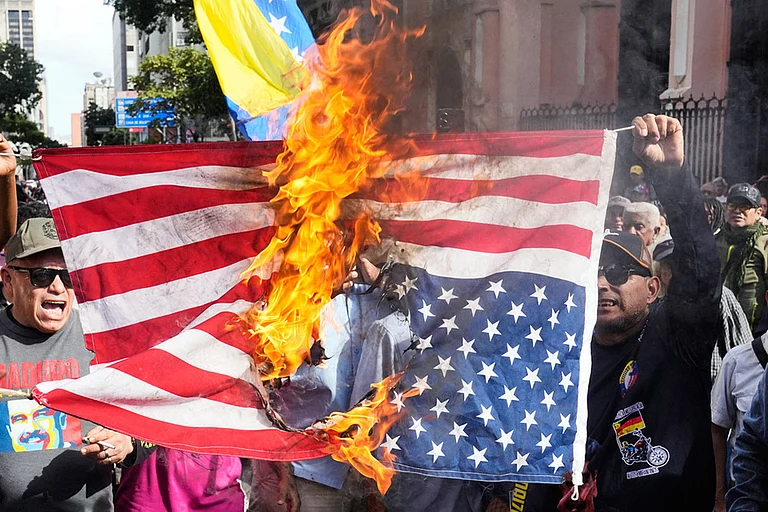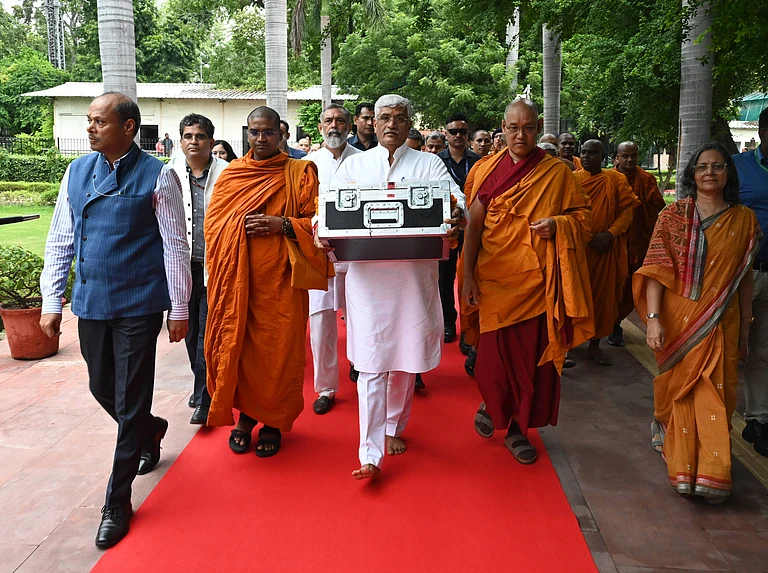Pilot Gaurav Bohara was about to take off from Chandragadi airport, near the southeastern border of Nepal, when the ground started heaving. “It was as if I was standing on still water and there were waves beneath my feet. It took a while for it to sink in that it was an earthquake. I had no option but to fly out immediately or else all of us would have got stranded there. The air seemed safer,” says Bohara. But he could not land the light atr 72 craft at the Tribhuvan airport because the air traffic controllers had deserted their post and clambered down to the ground floor to save themselves. A friend piloting a private chopper for aerial surveys helped him land safely.
Footage from CCTV cameras in Kathmandu show roads suddenly starting to shake and buildings and monuments crumbling down. Electricity poles were felled like wild flowers in a storm and roads split apart as if they were slices of cake being torn apart by an invisible, giant hand. People indoor hung on to walls and metal grills, many of which collapsed in no time.
Tragically, in rural Nepal, many seemed to have chosen indoors, unsure of what to do. People at Namchi Bazaar, an important stop on the way to the Everest base camp, were in a sense lucky. Since it was peak season, there were an estimated 1,000 foreign travellers there at the time—they managed to convince most local residents to move outdoors before the houses collapsed.
The Thamel area of Kathmandu is chock-full of budget hotels and shops operating out of buildings leaning on each other. When the buildings started crumbling, it seems there was not enough space for the staff or guests to get out of harm’s way. Just half an hour before the quake, a group of six women from Assam, all in their sixties, and the man accompanying them had checked into the ‘Budget Hotel’ in Thamel. Hema Saikia, Padma Majumdar, Rima Das, Bhonita Deka, Joysree Bera, Kalpana Adhikari and Bhoomika Das were frequent travellers. (Incidentally, Nepal also gets a large number of people from the Northeast who travel here for medical treatment.) The very first tremor brought down the hotel and the aftershocks churned the rubble further making later rescue efforts difficult. The occupants stood little chance.
The lone male member of the group, Abhijit, escaped with critical injuries and was flown to Delhi after six days. Padma Majumdar had not been found till the filing of this report, but it’s confirmed that her fellow travellers did not make it out alive.
Australian Tony Olejnicki runs a niche mountain adventure company in Kathmandu. He was near Budget Hotel as it came crashing down. While he joined a group of youth to search for people in the rubble, fresh aftershocks kept pushing the rubble back and there was a continuous risk of the rescuers being sucked in. “I have lived through many risky situations, seen really bad accidents but I’ve never had to pull out corpses. It sucked the life out of me,” recalls Olejnicki grimly.

Flight to safety An injured woman being carried to an Indian chopper in Lapu village, Gandaki zone, north-central Nepal. (Photograph by AFP, From Outlook 11 May 2015)
Olejnicki says the police and army came after a while, but mostly stood around impassively while civilians led the rescue effort. “The commander stood around quietly, arms folded, as I barked orders to his soldiers. These men had no tools, they did not know what to do. They were untrained and unprepared,” he says, adding, “two hours later, the administration sent bulldozers and these started creating more mayhem. The bodies buried in the rubble would probably have got crushed then if they hadn’t earlier. We had to stop them.”
The first tremor was followed by aftershocks, some of them causing nearly as much damage as the main quake. Those who had managed to escape out of their houses after the first tremor watched while their homes came crumbling down. In some interior districts, entire villages were wiped out. In Sindhupal Chowk, around 10,000 homes (built using the traditional stone-glued-with-mud technique) were destroyed; in Dhading district, 5,600 houses are no more.
Residents and tourists have continued to live in the open around the capital city. A large section can still be seen in Tudikhel in the Ratna Park area in the heart of Kathmandu. Initial fears were fuelled by a bizarre prediction on Radio Nepal (the only form of media available at the time) on Saturday itself, in which an astrologer predicted an even stronger quake that night.
The tourism industry in Kathmandu is dependent on migrant labour who cook, clean, guard, and manage the myriad hotels and restaurants. As they fled the city, all of Kathmandu looked like a war-ravaged zone, desolate, shops shut, shutters down everywhere, the buildings either crumbled to earth or with their sides opened up and exposed.
Till Wednesday night, none of the eateries were operating and there was no food except the instant noodles distributed through relief efforts and biscuits and nuts sold by hawkers. Water came at a premium on the first day but the government ensured it was distributed free at relief camps from Monday onwards.
Rescue operations have been on non-stop, relief material has been arriving from around the world. Indeed, it’s taken over the only international airport and tourists have had to wait to be evacuated, leading to frayed nerves. A group of frustrated Indians held placards blaming the Indian prime minister who, the placards read, “talked too much”. Sadly, Nepalese nationals at the airport are not given priority while large number of Indians and Europeans were quickly flown out of the country.
Tribhuvan airport has begun resembling a crowded mall on a weekend as flights hovered over Kathmandu and airport officials scrambled to create parking space. The situation had not improved till Thursday as planes carrying aid from Europe and North America were being diverted to airports in West Asia or New Delhi.
Lack of coordination, and the general chaos, meant a team of Indian doctors that reached the embassy here were waiting for four days to be deployed. A European doctor told Outlook that while hospitals in Kathmandu were well stocked, the government seemed unable to reach out to interior areas.
On Wednesday, 21,000 tents sent from all over the world lay at the airport, admitted a senior government official. While aid continues to flow in from both India and China, the Nepalese media reported a deadlock as officials debated about which neighbour’s aid to accept first and how much of it. Geopolitics makes both countries very important to Nepal, which cannot afford to antagonise either.

Big burp of life Four-month-old Sonit Awal, rescued alive from the debris of his home in Bhaktapur by Nepal armymen after a 20-hour effort
Indian military helicopters and advanced light helicopters (ALHs) have been used extensively to ferry relief material to remote regions and areas outside Kathmandu. But these helicopters were allowed to fly to only designated areas. The Nepalese government has restricted access of Indian choppers beyond a certain point, claiming they have the use of lighter choppers that can fly in higher altitudes at low-pressure and rarified-air zones such as the Everest and other base camps (the remove being that though India is a country with at least 10 states in the Himalayan region, it does not seem to have these helicopters or it did not make them available to Nepal for the rescue mission). An Indian official speculated that this could be just an excuse to restrict access to security zones on China’s orders.
The Indians have, however, set up two field hospitals that could be treating thousands at Cenamangal and Lyankhel. The Uttar Pradesh government has sent 18 trucks of food and essential supplies to the Nepal home minister. Power Grid Corporation of India Ltd has set about restoring power substations around the country while Nepal Telecom has set up many mobile cellphone towers at camps.
Many tourists have lost all their personal belongings. On Wednesday, a mother with an infant in her arms ran around the whole day trying to convince officials that she had lost her documents, cash and everything else. No official was available to give an undertaking and arrange for her to leave Nepal.
Tourism in Nepal around this time of the year is centred around mountain treks and climbing. The earthquake set off some avalanches but other than those at the first Everest base camp (at about 19,000 feet), reports trickled in that most mountaineers were safe. The aftershocks made it tricky and uncertain though. On Sunday, a group of 10 mountaineers from Assam reported they were safe but since then there has been no trace of them. The group, led by Manas Bora and journalist Pranay Bordoloi, have been untraceable till now (they were on their second attempt to scale the Everest peak).
As in the wake of any major natural disaster, the Nepal quake too has produced both heroes and villains. While the Nepali youth by and large have stepped up to help in any way they can, there have been some out to make a quick buck out of the crisis. Packaged food and water bottles were selling at a premium. Bottled water normally costing about INR 30 were being sold for upwards of INR 300. When the government started to supply free water, the prices came down. But the taxis still overcharged. At the Pashupatinath ghat, those in charge of the cremations (right behind the temple) were charging a high premium even though the Nepal government and its Indian counterpart had provided firewood to build the pyres.
Medicines were available, but were being sold at high prices from behind downed shutters initially but later disappeared altogether. The situation improved slightly when a semblance of normalcy set in late on Thursday (Day 6). In the coming days, one of the most important relief issues in is likely to be medical relief and ensuring healthcare and sanitation. Since people continue to live out in the open, the Nepalese government has had to ensure they have tents, food, safe drinking water and access to toilets. On Wednesday, Nepalese army soldiers were fumbling with portable toilets in various relief camps, finally giving up as the people themselves dug up the earth to fashion makeshift toilets on the periphery of the parks they were living in. Naturally, these are already a breeding ground for germs and diseases. The administration has been spraying mosquito repellents and dusting bleaching powder in these areas as the open-air toilets (barely covered on the sides with plastic sheets) multiply as the camps swell.
There are international aid agencies that have started work there such as Medicins Sans Frontiers. They have flown in doctors experienced in working in crises situations. msf has been given only one helicopter to operate its mobile hospital. Access to several areas is restricted for them too.
And it isn’t just foreigners, one of Nepal’s largest corporates, the Choudhary group (popular for its Wai Wai brand of instant noodles) has also found its relief efforts stymied with access denied to several areas for “security reasons”.
Meanwhile, the Nepalese diaspora has also swung into action. Som Tomang flew in from Australia (his brother died when their house in Badase village Sindhupal Chowk collapsed), bringing with him volunteers. They are hoping to go into the remote districts and help with the relief efforts. Many of these are impoverished and do not have many able-bodied men, most having migrated out of the country or to Kathmandu in search of livelihoods.
By Ushinor Majumdar in Kathmandu

























